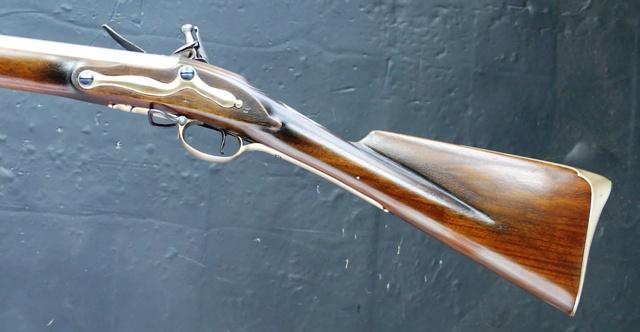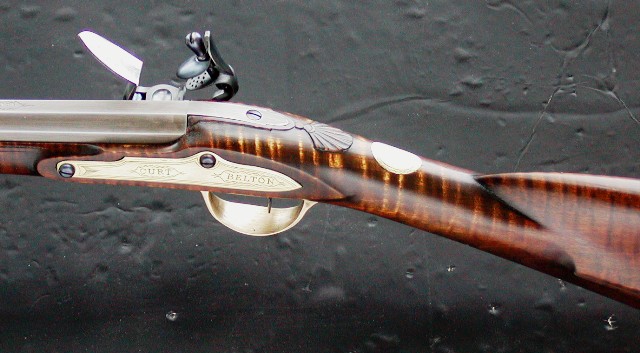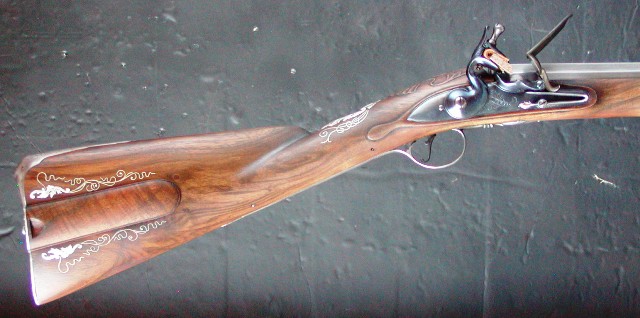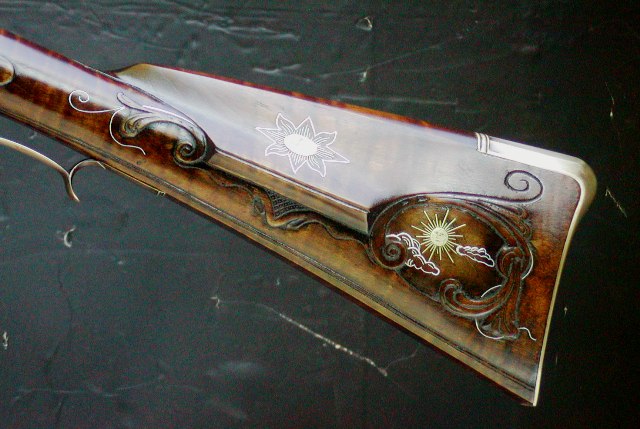I'm considering building the Traditions Deluxe Kentucky Rifle Kit. I'm familiar with simple hand rubbed oil finishes on stocks but want some input on other finishes I should consider. Also, should I go blued or browned on bare metal parts and why should I go that way? This will be my first build and I will more than likely get a better kit down the road. Its gonna be a working gun putting meat on the table but I do want it to look nice.
You are using an out of date browser. It may not display this or other websites correctly.
You should upgrade or use an alternative browser.
You should upgrade or use an alternative browser.
Boiled Linseed Oil Finish?
- Thread starter UplandHunter
- Start date

Help Support Muzzleloading Forum:
This site may earn a commission from merchant affiliate
links, including eBay, Amazon, and others.
If you are looking for reasons not to use BLO you will get plenty of replies I am sure. But I can’t give you any.
BLO=worst you can use.
If you are looking for reasons not to use BLO you will get plenty of replies I am sure. But I can’t give y
What would you recommend?BLO=worst you can use.
WadeP
32 Cal
Here’s some:If you are looking for reasons not to use BLO you will get plenty of replies I am sure. But I can’t give you any.
It will take many applications over many days and lots of buffing.
After all that work, it’ll look nice but require frequent touchups and will never repel water.
Lots of products that are made for gunstocks. Don’t reinvent the wheel.
If you are looking for reasons not to use BLO you will get plenty of replies I am sure. But I can’t give you any.
For an oil finish I love real Tung oil. It isn’t a quick process, but if you are patient, it will result in a great oil finish, way better than BLO. But that is just one person’s opinion.What would you recommend?
Tung oil is my preferred finihs. LBO is OK if you want to spend months of labor to get a soft not very good finish. Depending on how you want it to look when done, Tru Oil makes a nice durable finish but its pretty labor intensive also.
- Joined
- Dec 15, 2016
- Messages
- 1,569
- Reaction score
- 3,975
I can give you a reason why not, drying time. I used BLO on a shooting box, applied as recommended and rubbed it back. The box has never left the house, never been in the heat or sun, yet after 34 years, I still have to tap on it to get it to open. The outside is dry and looks nice, but the lid always sticks to the box. My old man warned me, I just didn't listen.
If you have BLO your wanting to use, mix thos combination; 60% Tung Oil, 30% Boiled Linseed Oil and 10% Mineral Spirits. It's very close to Tru-oil, homemade version, applies the same way. I add a couple drops of Japan drier to speed up drying time.
If you have BLO your wanting to use, mix thos combination; 60% Tung Oil, 30% Boiled Linseed Oil and 10% Mineral Spirits. It's very close to Tru-oil, homemade version, applies the same way. I add a couple drops of Japan drier to speed up drying time.
- Joined
- Nov 26, 2005
- Messages
- 5,229
- Reaction score
- 10,908
Hi,
Probably every new builder on this sight has posted the same question. There are many finishes that work well. BLO sold today in hardware stores is linseed oil mixed with solvents to speed drying. It is not the same as what was traditionally called "boiled linseed oil", which was actually an oil varnish. It contained some sort of resin to create a varnish and was much more weather resistant than pure linseed oil. Pure oils like linseed or tung take forever to dry and no old time or modern gunsmith can afford to spend months on a finish that ultimately is mediocre. Mixing linseed oil with a varnish like spar or polyurethane will work well, dry quickly and looks a lot like the old BLO finishes. Tried and True makes a fine linseed oil varnish that many top gunmakers use. Another option is to heat treat (polymerize) the oil and mix with solvents. Tru Oil is just linseed oil polymerized and mixed with solvents and works pretty well. You can also get polymerized tung oil, which is even better. Sutherland-Welles is one brand and is the finish I use. There are also synthetically produced finishes such as Permalyn that are popular although they can impart a plastic look to the finish if built up too much. In my work, I want a finish that is reasonably weather resistant, can be repaired if needed, and looks like the old finishes found on original guns. Here are examples of guns finished with polymerized tung oil.





The look ranges from somewhat glossy to a low sheen depending on my objectives.
dave
Probably every new builder on this sight has posted the same question. There are many finishes that work well. BLO sold today in hardware stores is linseed oil mixed with solvents to speed drying. It is not the same as what was traditionally called "boiled linseed oil", which was actually an oil varnish. It contained some sort of resin to create a varnish and was much more weather resistant than pure linseed oil. Pure oils like linseed or tung take forever to dry and no old time or modern gunsmith can afford to spend months on a finish that ultimately is mediocre. Mixing linseed oil with a varnish like spar or polyurethane will work well, dry quickly and looks a lot like the old BLO finishes. Tried and True makes a fine linseed oil varnish that many top gunmakers use. Another option is to heat treat (polymerize) the oil and mix with solvents. Tru Oil is just linseed oil polymerized and mixed with solvents and works pretty well. You can also get polymerized tung oil, which is even better. Sutherland-Welles is one brand and is the finish I use. There are also synthetically produced finishes such as Permalyn that are popular although they can impart a plastic look to the finish if built up too much. In my work, I want a finish that is reasonably weather resistant, can be repaired if needed, and looks like the old finishes found on original guns. Here are examples of guns finished with polymerized tung oil.





The look ranges from somewhat glossy to a low sheen depending on my objectives.
dave
Last edited:
BarBrig
32 Cal
Beautiful craftsmanship! I would like to learn how to do the wire inlay.Hi,
Probably every new builder on this sight has posted the same question. There are many finishes that work well. BLO sold today in hardware stores is linseed oil mixed with solvents to speed drying. It is not the same as what was traditionally called "boiled linseed oil", which was actually an oil varnish. It contained some sort of resin to create a varnish and was much more weather resistant than pure linseed oil. Pure oils like linseed or tung take forever to dry and no old time or modern gunsmith can afford to spend months on a finish that ultimately is mediocre. Mixing linseed oil with a varnish like spar or polyurethane will work well, dry quickly and looks a lot like the old BLO finishes. Tried and True makes a fine linseed oil varnish that many top gunmakers use. Another option is to heat treat (polymerize) the oil and mix with solvents. Tru Oil is just linseed oil polymerized and mixed with solvents and works pretty well. You can also get polymerized tung oil, which is even better. Sutherland-Welles is one brand and is the finish I use. There are also synthetically produced finishes such as Permalyn that are popular although they can impart a plastic look to the finish if built up too much. In my work, I want a finish that is reasonably weather resistant, can be repaired if needed, and looks like the old finishes found on original guns. Here are examples of guns finished with polymerized tung oil.





The look ranges from somewhat glossy to a low sheen depending on my objectives.
dave
I like Minwax Tung OIl Finish, which is sure to get blasted by the purists as "not real tung oil", and is a valid point, as it's a mix similar to other mixes described above, but it's a lot easier, a lot faster, and the end result is maybe 90% of a "real" tung oil finish. If they didn't know any better, the casual observer wouldn't know the difference. IMO Birchwood-Casey TruOil has a problem of drying too shiny, and its sheen needs to be knocked down, then brought partially back by burnishing and/or waxing, which adds a lot of extra work. But that's just a personal preference for how I like my stocks to look. Otherwise, I'd rate it as a close second to Minwax Tung Oil Finish for speed, ease of use and end result.
Last edited:
No. Raw Linseed Oil is even worse as it never cures over the users lifetime. Tool collectors soak wooden hand planes in it. It causes the wood to swell closing small cracks. Supposedly reversible by soaking in turps, but I've never tried that.BLO=worst you can use.
- Joined
- Nov 1, 2018
- Messages
- 3,885
- Reaction score
- 2,914
I'm considering building the Traditions Deluxe Kentucky Rifle Kit. I'm familiar with simple hand rubbed oil finishes on stocks but want some input on other finishes I should consider. Also, should I go blued or browned on bare metal parts and why should I go that way? This will be my first build and I will more than likely get a better kit down the road. Its gonna be a working gun putting meat on the table but I do want it to look nice.
I wouldn’t use BLO, I’d use linspeed perhaps, or tried and true… they’re treated with driers and are much easier to apply.
However BLO is really good at starting fires ! Soak some scrap wood in it, leave it in the sun to dry and you’ve got some great kindle.
My two GO-TO stocks finishes are Permalyn Sealer and Tru-Oil thinned. I've been using these two for a LONG time and got to know how to apply and finish them to the way I like with a satin sheen. There are other finishes out there pick one and give it a try on some scrap wood and if you don't like it try another. I also will seal the wood sometimes with shellac first then put either of the two finishes I noted over the shellac.
- Joined
- Aug 10, 2019
- Messages
- 445
- Reaction score
- 490
I've taken to rubbing my wood stocks and leather items with Ballistol. I had always used linseed oil, but here in the coastal marshlands the humidity caused a fine white mold to beset some wood and leather, even with the AC cranked up. So far no reappearances of said white mold. Also, the Ballistol leaves a soft, gleaming finish.
Dave person is the best! he has forgotten more than i will ever know. his advice is golden. but when i use oil on wood, this is it. https://www.realmilkpaint.com/shop/oils/pure-tung-chinawood/
it dries fast and is real tung oil from the tree. but the key to making it look good is the wood prep. get the wood smooth and slick and the oil will look great.
it dries fast and is real tung oil from the tree. but the key to making it look good is the wood prep. get the wood smooth and slick and the oil will look great.
I was just about to quote your Building a 1756 Long Land musket thread where you talk about finishes.Hi,
Probably every new builder on this sight has posted the same question. There are many finishes that work well. BLO sold today in hardware stores is linseed oil mixed with solvents to speed drying. It is not the same as what was traditionally called "boiled linseed oil", which was actually an oil varnish. It contained some sort of resin to create a varnish and was much more weather resistant than pure linseed oil. Pure oils like linseed or tung take forever to dry and no old time or modern gunsmith can afford to spend months on a finish that ultimately is mediocre. Mixing linseed oil with a varnish like spar or polyurethane will work well, dry quickly and looks a lot like the old BLO finishes. Tried and True makes a fine linseed oil varnish that many top gunmakers use. Another option is to heat treat (polymerize) the oil and mix with solvents. Tru Oil is just linseed oil polymerized and mixed with solvents and works pretty well. You can also get polymerized tung oil, which is even better. Sutherland-Welles is one brand and is the finish I use. There are also synthetically produced finishes such as Permalyn that are popular although they can impart a plastic look to the finish if built up too much. In my work, I want a finish that is reasonably weather resistant, can be repaired if needed, and looks like the old finishes found on original guns. Here are examples of guns finished with polymerized tung oil.





The look ranges from somewhat glossy to a low sheen depending on my objectives.
dave
What are your thoughts on Watco Danish Oil?
Or leave some rags you wiped some up with laying around in your shop, makes a dandy spontaneous combustion fire.I wouldn’t use BLO, I’d use linspeed perhaps, or tried and true… they’re treated with driers and are much easier to apply.
However BLO is really good at starting fires ! Soak some scrap wood in it, leave it in the sun to dry and you’ve got some great kindle.
- Joined
- Jan 24, 2005
- Messages
- 3,281
- Reaction score
- 6,637
For a durable yet sacrilegious finish, particularly if you’re going to hunt in wet weather.
Finish sanding and raise the grain but don’t whisker then apply a coat of spar varnish/“plastic” varnish or any modern finish that is waterproof and dries quickly.
When dry sand off the raised grain [which is now solid with soaked in finish], couple more coats, then rub back to a semi gloss finish [or use semi gloss from the start], rub with a bit of linseed oil, now and then, for smell and reap the praise for a good oil finish.
Finish sanding and raise the grain but don’t whisker then apply a coat of spar varnish/“plastic” varnish or any modern finish that is waterproof and dries quickly.
When dry sand off the raised grain [which is now solid with soaked in finish], couple more coats, then rub back to a semi gloss finish [or use semi gloss from the start], rub with a bit of linseed oil, now and then, for smell and reap the praise for a good oil finish.
ernbar
45 Cal.
BLO is ok but I like Daish oil better. I use the one with pigment from Home Depot and produces great results. I have done several grips with the dark walnut color. Just refinished these two a couple of days ago.




Similar threads
- Replies
- 2
- Views
- 267
- Replies
- 22
- Views
- 1K
- Replies
- 7
- Views
- 987



